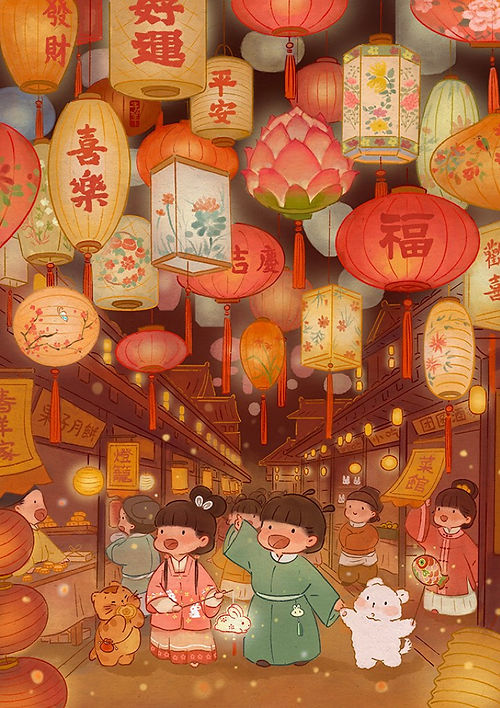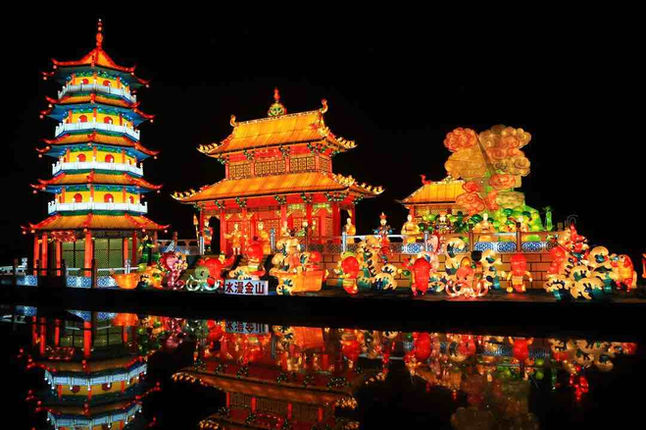Lantern Festival — Traditional Chinese Valentine's Day and The End of Spring Festival Celebration
Lantern Festival, also named Shangyuan Festival or Yuanxiao Festival, falls on the 15th of January in the Traditional Chinese Calendar, marking the first full moon of the new year.
It is also the end of the Chinese New Year (also known as the Spring Festival) celebration.
Following all the Lantern Festive activities, New Year's decorations are packed up, and life returns to normal.

Painting "Ming Xianzong Yuanxiao Xingle Tu" About Chenghua Emperor (1447 — 1487) Celebrating Lantern Festival in Imperial Forbidden City, by Court Artist of the Ming Dynasty — National Museum of China
When is the Lantern Festival
The Lantern Festival falls on the 15th of January in the Traditional Chinese Calendar, but its preparation and celebration time have varied from one day to ten days throughout history.
Nowadays, beautiful lanterns typically adorn the surroundings for at least three to five days.

Hanging Lanterns in the Forbidden City, the Imperial Palace of Ming and Qing Dynasties (1368 — 1912), Photo From Official Website of Palace Museum.
Origin and History of Lantern Festival in China
The Lantern Festival originated in the Han Dynasty (202 BC — 220 AD), but there are several versions concerning the starting story.
Emperor Wen of Han, Liu Heng (202 BC — 157 BC), established the festival to commemorate the successful suppression of a rebellious plot initiated by the family of Empress Lv, the first queen of the Han Dynasty and the wife of Emperor Liu Bang.
The loyal generals and officials of Han achieved victory on the 15th of January, prompting Emperor Wen to declare this day a festival celebrated by all, symbolizing peace and loyalty.

Imperial Jade Seal of Empress Lv — Shaanxi History Museum (Photo by Dongmaiying)
Liu Che (156 BC — 87 BC), Emperor Wu of Han, began the worship of Tai Yi Shen, the most honorable and supreme deity of heaven, on the first full moon of the new year.
Emperor Liu Che's worship ceremony was elaborate, spanning from dusk until the following day.
The palace was adorned with countless lights, and sometimes meteors added to the spectacle.
As a result, this day evolved into an important festival featuring beautiful lanterns and grand worship ceremonies.

Tai Yi Shen and other Immortals in Ancient Chinese Culture
In Taoism Religion, the first full moon night marks the birthday of Shangyuan, an honorable deity responsible for fortune and blessings.
Therefore, this day is also known as the Shangyuan Festival, during which people illuminate countless lanterns to celebrate the birthday of Deity Shang Yuan and pray for good luck.
Traditionally, civilians would carry torches at night to ward off monsters and pests in their farmlands, protecting their crops.
Over time, the 15th of January evolved into a festival of torches and lights, providing an opportunity for people to come together and celebrate at night.

Different Types of Beautiful Lanterns of the Song Dynasty, in Painting "Guandeng Tu" By Artist Li Song (about 1166 — 1243) — Taipei Palace Museum
Why is Lantern Festival Traditional Chinese Valentine's Day
In ancient Chinese history, except during the Song Dynasty (960 — 1279), curfew had been implemented strictly for safety reasons.
During the night, city walls and all shops would be closed, and ordinary citizens were not allowed to go out on the streets, except for patrollers and those facing emergencies.
However, during the Shangyuan Festival, everyone was permitted to go out at night and participate in various celebration activities.
Beautiful Lanterns' Gala or Denghui
Especially for young and unmarried people who could not go out and date freely as people do today, the festival provided an excellent opportunity to see and meet others.
Even for married couples, going out at night is romantic and sweet.
The full moon, fancy lanterns, beautiful firecrackers, and outstanding performances formed a splendid night.
Therefore, the Lantern Festival has come to be considered as Chinese Valentine's Day.
Customs and Traditions of the Chinese Lantern Festival
-
Attend gatherings of the festival.
-
Guess Lantern Riddles.

-
Watch beautiful Firecrackers.
-
Send exquisite lanterns to newly married brides (usually from parents or close relatives) to pray for their well-being and fortune.
-
Eat Glutinous Rice Balls (Yuanxiao and Tangyuan).

Popular Folk Performances of Lantern Festivals in China
Performances during the Lantern Festival are mostly the same as those in the Chinese New Year (or Spring Festival), such as Dragon and Lion Dances.
Click to Read More Celebration Performances of Chinese New Year
You Might Also Like:
Chinese Lanterns — History, Utilization, Tradition, Culture, and Artifact
Chinese Festivals — Celebration, Custom, and Food
Chinese New Year — Spring Festival
New Year Greetings and Spring Festival Couplets
Qingming Festival the Tomb Sweeping Day
Dragon Boat Festival — Duanwu in China
Qixi Festival the Double Seventh — Women's Holiday and the Love Legend of Vega
Ghost Festival, or Zhongyuan Festival — Worship of the Deceased
Mid-Autumn Festival Or Zhongqiu — Holiday of Reunion and Mooncake
Double Ninth Festival, the Chongyang
Chinese Calendar the Lunisolar Calendar
Lucky Flowers of 12 Months in Chinese Calendar
Chinese Astrology — Three Enclosures, Four Symbols, Twenty-eight Lunar Mansions






